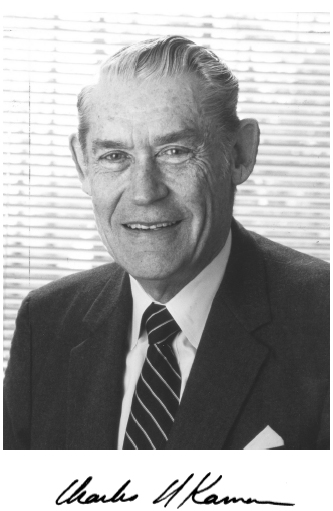
1919–2011
Elected in 1967
“For aeronautical research and development.”
BY KEN ROSEN
CHARLES H. KAMAN, one of the original pioneers of the American helicopter industry and a world-famous inventor and entrepreneur, died on January 31, 2011, at age 91.
Charlie was born on June 15, 1919, in Washington, DC, the only child of Charles William and Mabel Davis Kaman. His interest and aptitude in aviation revealed themselves early as he built model airplanes from balsa wood and flew them in indoor competitions. In high school he set national duration records for hand-launched model gliders.
He received a bachelor’s degree (magna cum laude) in aeronautical engineering from the Catholic University of America in 1940, and eventually went on to receive honorary doctorates from the University of Connecticut, the University of Colorado, and the University of Hartford, of which he was one of a group of founders.
After graduation, he went to work for the Hamilton Standard Propeller Corp., which was then a unit of United Aircraft Corp. (now United Technologies Corporation). In Connecticut he soon met Igor Sikorsky, the famous helicopter pioneer and head of Sikorsky Aircraft, who became an inspiration to Charlie.
In 1945 Charlie founded the Kaman Aircraft Corp. on a shoestring ($2,000 invested by friends) and led the company as CEO for 55 years. He started the company to demonstrate a new rotor concept intended to make helicopters more stable and easier to fly. He succeeded, and his first machine, the K-125, achieved first flight on January 15, 1947, when Charlie was 27 years old.
The fledgling business of vertical flight was very risky and helicopters were somewhat unstable and very difficult to fly. Charlie developed a novel system of rotor control based on “servo flaps,” small ailerons added to the trailing edges of the rotor blade to improve helicopter stability. He also refined the idea of intermeshing counterrotating rotors, which increased lift and eliminated the need for a tail rotor. These innovations became standard in all subsequent Kaman designs.
The company grew to provide products and services for the industrial, commercial, and defense markets, including advanced multimission helicopters, UAVs, software systems, scientific studies, missile devices, next-generation electromagnetic motors, and commercial aircraft structures. And when Charlie developed an interest in making composite-material guitars, his business incorporated worldwide musical instrument manufacturing and distribution—and Kaman Music Corp. became the largest independent distributor of musical instruments and accessories in the United States.
The Kaman Corp. now employs more than 5,000 people at more than 250 locations in the United States, Canada, Mexico, and Europe. Specific product achievements include the Kaman K-125 helicopter, which first flew in 1947, utilizing intermeshing rotors and Kaman’s patented servo-flap stability control. In 1951, he developed the Kaman K-225, the world’s first helicopter to be powered by a gas turbine engine. Later, Charlie was the lead designer of the Kaman HOK-1, the HH-43 Husky, the SH-2G Super Seasprite maritime helicopter, and the K-MAX® “aerial truck.” He was most proud of the more than 15,000 lives that Kaman helicopters were estimated to have saved in rescue missions over the second half of the 20th century.
Throughout his career, Charlie led the way in developing a wide range of vertical takeoff and landing (VTOL) technologies such as compound helicopters, convertiplanes, jet-driven rotors, rotor chutes, and drones. His achievements are highlighted by an outstanding list of “firsts”—the first servo-controlled rotor, first gas turbine–powered helicopter, first production all-composite rotor blade, first remotely controlled helicopter, and first helicopter (H-43B) to complete its service life with no accidents or loss of life.
Charlie Kaman earned a very large number of awards, citations, and honors throughout his long career. Notably, in 1996 he received the National Medal of Technology from President Clinton, and in 1967 he was elected to the National Academy of Engineering. He was also a fellow of the American Institute of Aeronautics and Astronautics (AIAA), an Honorary Fellow of the Royal Aeronautical Society, an International Honorary Fellow of the American Helicopter Society (AHS), and he earned the prestigious Dr. Alexander A. Klemin Award, given by AHS “for notable achievement in the advancement of rotary wing aeronautics.” In 1997 he received both the nation’s premier aviation award—the National Aeronautic Association’s Wright Brothers Memorial Trophy—and the Navy League’s highest award, the Fleet Admiral Chester W. Nimitz Award, which recognized his leadership, statesmanship, and contributions to our nation’s security. Charlie was also a charter member of the Aviation Hall of Fame and in 1996 was inducted into the US Naval Aviation Hall of Honor at the National Naval Aviation Museum. Additionally, he received the Connecticut Medal of Technology, the US DOD Distinguished Public Service Medal, and the Aviation Week and Space Technology Laurel.
Aside from his professional accomplishments, Charlie was much admired for his humanitarian interests. In 1981 he founded, together with his wife Roberta, Fidelco Guide Dog Foundation, New England’s only guide dog school. Fidelco’s pioneering “in-community” training program makes it possible for a blind person to remain at home, and at work, while being trained with a Fidelco guide dog. Fidelco has placed 1,300
guide dogs in 35 states and four Canadian provinces. And in 1987 he received the National Human Relations Award from the National Conference of Christians and Jews.
Charles H. Kaman was an aviation innovator and giant. He was the last of the helicopter “pioneers” who created the American vertical flight business and made it the envy of the world. He should be remembered as a courageous and committed entrepreneur, inventor, and humanitarian. He will be greatly missed.






